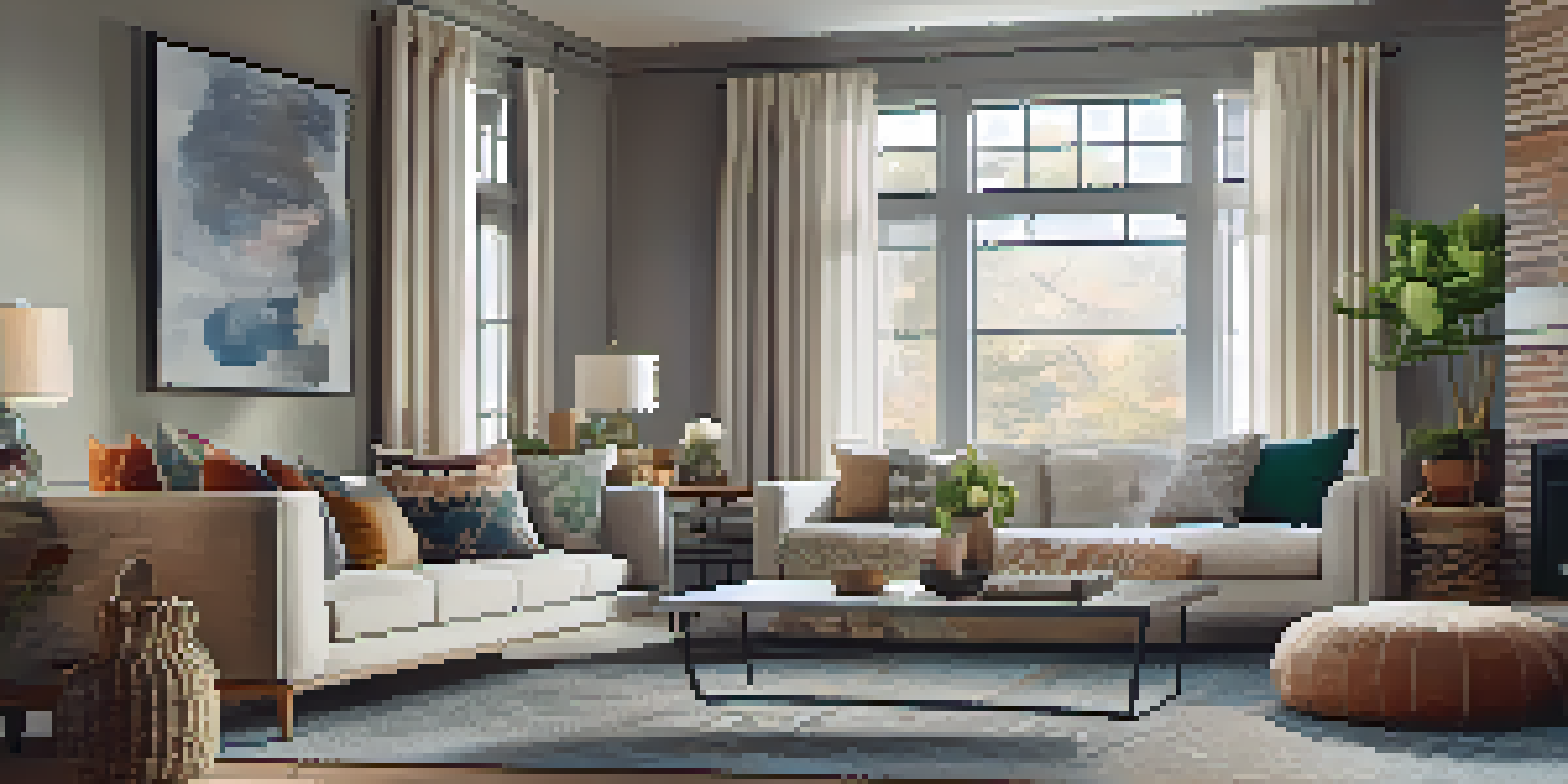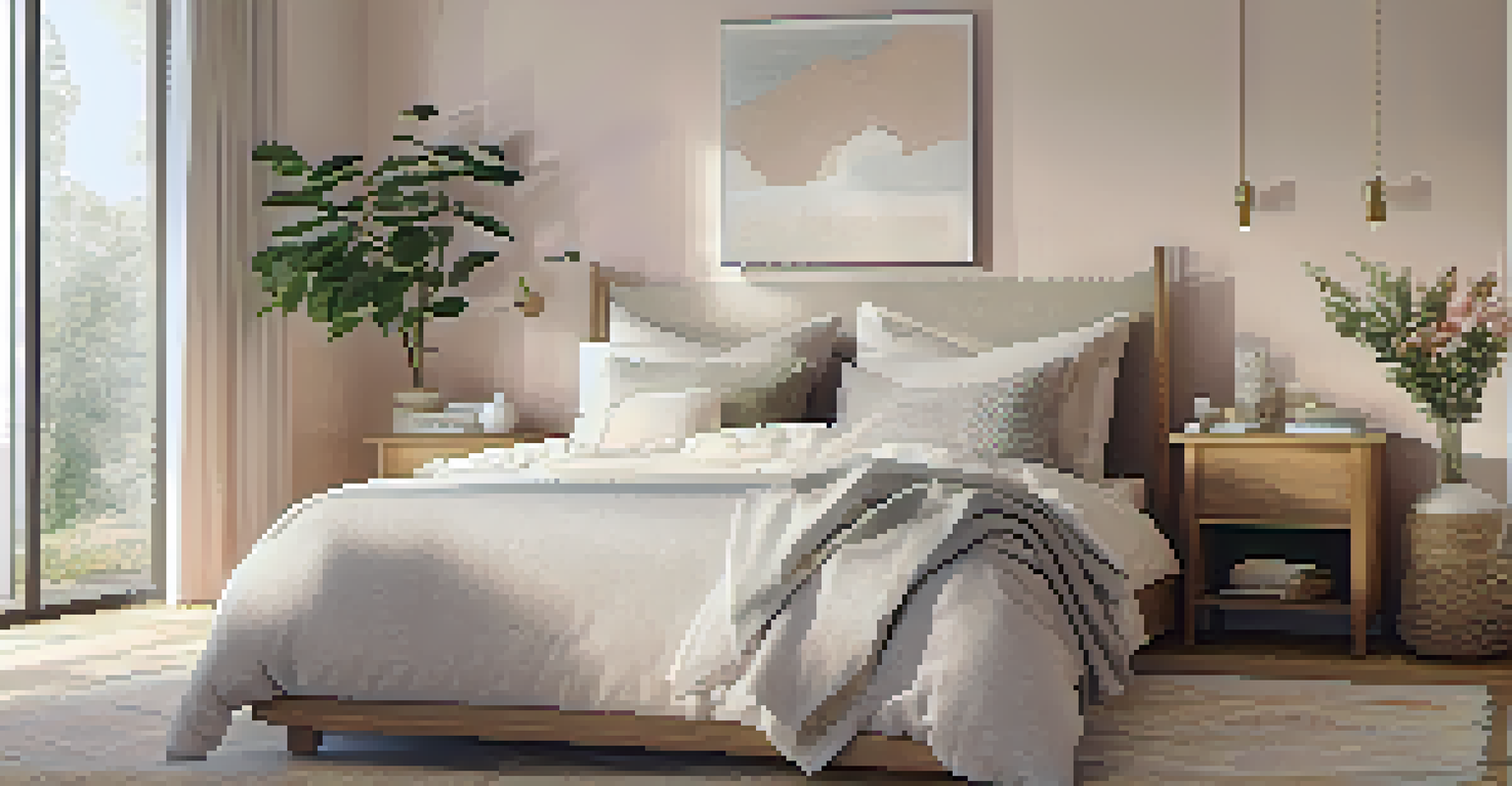The Role of Textiles in Creating Timeless Interiors

Understanding the Importance of Textiles in Interiors
Textiles play a crucial role in defining the character of any space. They add warmth, texture, and color, making a room feel inviting and comfortable. Without textiles, interiors can feel cold and unwelcoming, much like an empty canvas awaiting a painter’s touch.
Textiles are the skin of a space; they create the mood and character of a room.
Think of a room filled with hard surfaces—walls, floors, and furniture made of metal or wood. While these materials are visually striking, they lack the softness and coziness that textiles provide. Incorporating fabrics, from curtains to cushions, transforms the atmosphere, enhancing both aesthetics and comfort.
Moreover, textiles can reflect your personality and style. Whether it’s a vibrant throw pillow or a neutral area rug, these elements allow you to express who you are while creating a timeless space that feels uniquely yours.
Choosing the Right Textiles for Your Space
Selecting the right textiles is essential for achieving a cohesive look. Consider the color palette and overall theme of your room—this will guide your choices in fabric types and patterns. For instance, a serene, minimalist space may benefit from soft linens, while a bohemian vibe might call for bold prints and textures.

When choosing textiles, also think about functionality. High-traffic areas like living rooms may require durable fabrics that can withstand wear and tear, while bedrooms can embrace softer, more delicate options. This balance ensures that your interiors remain both stylish and practical.
Textiles Define Room Character
Incorporating textiles like curtains and cushions adds warmth and personality to interiors, transforming cold spaces into inviting environments.
Don’t shy away from mixing different textiles. Combining materials like velvet, cotton, and wool can create depth and interest, ensuring your space feels dynamic and inviting. Just remember to maintain a sense of harmony through colors and patterns to keep the overall feel timeless.
Textiles as a Tool for Creating Mood
Textiles have a remarkable ability to influence the mood of a space. Soft, flowing curtains can evoke a sense of tranquility, while vibrant cushions can energize a room. By thoughtfully selecting textiles, you can curate an atmosphere that resonates with your desired emotional response.
Good design is about the perfect balance between aesthetics and function.
For example, if you want to create a cozy reading nook, opt for plush fabrics and warm tones that invite relaxation. On the other hand, if you're designing a lively dining area, bright, eye-catching textiles can enhance the energy and excitement of the space.
This emotional connection can be further enhanced with seasonal textiles. Switching out fabrics for different seasons—like light, airy materials for summer and rich, warm textiles for winter—can keep your interiors feeling fresh and relevant year-round.
The Role of Texture in Timeless Design
Texture is a key factor in creating depth and interest in interior design. Various textiles, from rough burlap to smooth silk, can interact to create a layered look that captivates the eye. This tactile dimension not only enhances visual appeal but also invites touch, making a space feel more lived-in.
Consider how different textures can be combined to create contrast. Pairing a chunky knit throw with sleek leather furniture can bring balance to your design. This interplay between textures fosters a cozy yet sophisticated atmosphere that stands the test of time.
Choose Textiles for Functionality
Selecting the right textiles based on room function and aesthetic ensures a balance between style and durability in your design.
In timeless interiors, texture plays a significant role in achieving a sense of harmony. By thoughtfully incorporating a variety of textiles, you can create a balanced environment that feels rich and inviting, ensuring your design remains relevant through changing trends.
Incorporating Patterns into Your Textile Choices
Patterns can add character and vibrancy to your interiors, but they should be used judiciously. A well-placed patterned textile can serve as a focal point, drawing the eye and adding visual interest. However, too many competing patterns can create chaos, so finding the right balance is key.
When integrating patterns, consider the scale and style. Large-scale patterns can dominate a space, while smaller patterns often serve as subtle accents. Mixing patterns can also be effective; just ensure they share a common color palette to maintain cohesion.
Timeless designs often embrace classic patterns like stripes, florals, or plaids. These patterns have endured through the years for a reason—they evoke nostalgia and can seamlessly blend with various decor styles, ensuring your interiors remain stylish for years to come.
Sustainability in Textile Selection
In today's world, sustainability is more than a buzzword—it's a necessity. Choosing eco-friendly textiles not only benefits the environment but also contributes to creating a healthier indoor environment. Look for materials made from organic fibers or recycled materials to make responsible choices.
Sustainable textiles often come with unique textures and colors that can add an organic touch to your interiors. These materials can tell a story, enhancing the character of your space while promoting eco-conscious living.
Sustainable Choices Matter
Opting for eco-friendly textiles not only benefits the environment but also enhances the character and longevity of your interiors.
Incorporating sustainability into your textile choices can also mean investing in quality over quantity. Durable textiles stand the test of time and reduce the need for frequent replacements, making them a smart choice for timeless design.
Maintaining Your Textiles for Longevity
To ensure that your textiles remain beautiful over time, proper maintenance is essential. Regular cleaning, whether through vacuuming rugs or washing cushion covers, can prevent dirt and grime from building up, preserving their appearance and texture.
Pay attention to the specific care instructions for each type of fabric. Some may require special cleaning methods, while others can withstand more rigorous handling. Understanding these nuances allows you to maintain your textiles effectively and prolong their life.

Additionally, consider rotating your textiles seasonally to avoid sun damage and fading. By being proactive in your care, you can enjoy your textiles' beauty and functionality for years, contributing to the timelessness of your interiors.